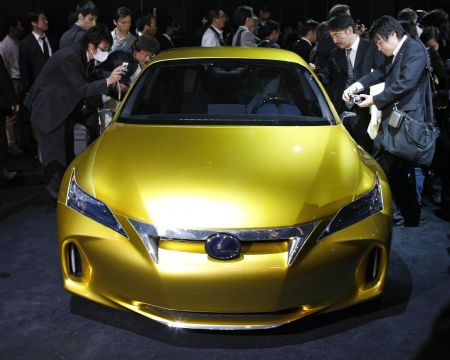Tokyo Motor Show Pushes Environmental Envelope
Beneath a minimalist, yet irrefutably attractive body lays not one, but two electric motors, one on each axle. This, combined with a 1.6-liter, four cylinder, gasoline engine offering 92 lb-ft of torque, provide the PX-MiEV with plenty of get-up-and-go.
Under heavy loads, heavy acceleration or emergency maneuvers, another electric motor at the rear axle also kicks-in to provide extra power and help stabilize the vehicle. When the gasoline engine isn't needed, it either switches off or acts as a generator to recharge the battery or power the electric motors -- whichever is most efficient at any one moment. Each electric motor generates 60 hp and 148 lb-ft of torque. Mitsubishi says the PX- MiEV can achieve a range of 60 km/l.
As with all plug in hybrids the PX-MiEV can be used in electric only mode and has a range of 48 km, but hybrid mode can be called upon for acceleration, speed and for long-haul journeys.
In addition to determining the most efficient way to propel the PX-MiEV in any given circumstance, the computer can also use the electric motors to dole out torque both front-to-rear and side-to- side for maximum stability and traction. Cameras mounted around the vehicle, meanwhile, give the driver a birds-eye view for navigating in tight spaces -- so no more trouble with parallel parking.
Inside, the PX-MiEV features a futuristic design, equipped with touch-screen panels for all non-driving related controls. The minimalist interior comes with a horseshoe-shaped steering wheel crammed with buttons to activate the vehicle's many intramural systems (like navigation, temperature and entertainment) without the driver taking his or her hands off of the wheel. Heated and cooled seats in the car are coated with an anti-bacterial seat fabric. The PX-MiEV is coated in reflective paint and window coatings to keep interior temperatures down, thus reducing the energy needed for heating/air conditioning.
The PX-MiEV can be charged from a standard 110-volt wall socket, a 200-volt socket or a special high-voltage quick-charger. According to Mitsubishi the vehicle can also act as a giant battery pack and power household appliances to cut home energy costs, or act as a generator to provide electricity during a blackout.
Batteries Included
Japanese car manufacturers have always invested heavily in research and development and were actually infatuated with energy efficiency long before global warming was accepted as a worldwide reality. For decades Japanese companies have struggled to cope with their oil-poor country's sky-high energy costs by placing a premium on energy-saving technologies and, coupled with the western world's decree to break the shackles of its middle- eastern oil addiction and turn instead to sustainable domestic forms of 'new energy', the Japanese penchant for frugality and innovation could just pay off. Big time.
 |
|
Visitors look at the Lexus LF-CH hybrid concept car at the 41st Tokyo Motor Show in Chiba, east of Tokyo October 21, 2009.[Xinhua/Reuters Photo] |
"The Japanese economy relies heavily on developing and exporting electronic goods and cars. In Japan at the moment people aren't buying new cars because of the exchange rate and the global economic turndown. Production and export of Japanese cars are at an all time low. Most Japanese car manufacturers have been forced to shut down some of their assembly lines in their factories and restructure their workforces. The situation facing manufacturers in America is even more serious. However, although the short-term view for Japanese automakers, particularly for this fiscal year, is a little depressing, the market will recover and when it does international and domestic consumers will be more concerned with economy and environment than with status and power - - when this happens Japanese car manufacturers are perfectly placed with the history, technology and manufacturing infrastructure to capitalize and reverse the effects of the Japanese recession."
Perhaps though the biggest signs that Japan, as a nation, is one-step ahead of its counterparts in accepting the fact that cleaner, greener cars will become a worldwide norm is firstly the way in which Japanese automakers have aligned themselves with electrical companies, specifically those that make batteries and also the way society in general readily and rapidly embraces and adopts technical innovation and paradigm shifts into everyday life.
The key to Japanese automakers protecting their edge when it comes to green car projects, in light of the fact that hybrid technology is old news, is joining forces with makers of electronics and batteries. Toyota's joint venture with Panasonic has already made it one of the world's leading battery companies. Similarly, Nissan recently increased its stake in its own battery collaboration with NEC, investing in a new, gargantuan factory with the express aim of marketing its lithium-ion batteries to other carmakers. The future for cars, it would appear, is a battery operated one.
 0
0 







Comments